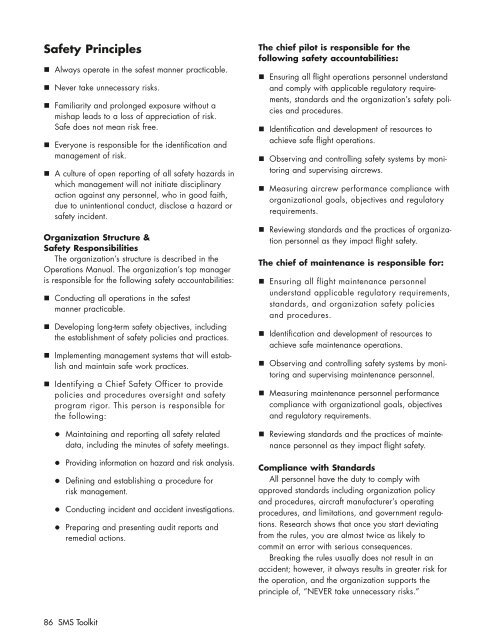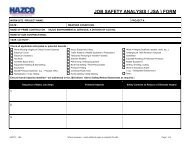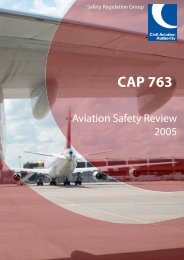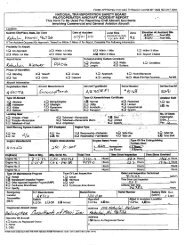International Helicopter Safety Team Safety Management System Toolkit
IHST - Safety Management Toolkit - Skybrary
IHST - Safety Management Toolkit - Skybrary
- No tags were found...
Create successful ePaper yourself
Turn your PDF publications into a flip-book with our unique Google optimized e-Paper software.
<strong>Safety</strong> Principles<br />
Always operate in the safest manner practicable.<br />
Never take unnecessary risks.<br />
Familiarity and prolonged exposure without a<br />
mishap leads to a loss of appreciation of risk.<br />
Safe does not mean risk free.<br />
Everyone is responsible for the identification and<br />
management of risk.<br />
A culture of open reporting of all safety hazards in<br />
which management will not initiate disciplinary<br />
action against any personnel, who in good faith,<br />
due to unintentional conduct, disclose a hazard or<br />
safety incident.<br />
Organization Structure &<br />
<strong>Safety</strong> Responsibilities<br />
The organization’s structure is described in the<br />
Operations Manual. The organization’s top manager<br />
is responsible for the following safety accountabilities:<br />
Conducting all operations in the safest<br />
manner practicable.<br />
Developing long-term safety objectives, including<br />
the establishment of safety policies and practices.<br />
Implementing management systems that will establish<br />
and maintain safe work practices.<br />
Identifying a Chief <strong>Safety</strong> Officer to provide<br />
policies and procedures oversight and safety<br />
program rigor. This person is responsible for<br />
the following:<br />
The chief pilot is responsible for the<br />
following safety accountabilities:<br />
Ensuring all flight operations personnel understand<br />
and comply with applicable regulatory requirements,<br />
standards and the organization’s safety policies<br />
and procedures.<br />
Identification and development of resources to<br />
achieve safe flight operations.<br />
Observing and controlling safety systems by monitoring<br />
and supervising aircrews.<br />
Measuring aircrew performance compliance with<br />
organizational goals, objectives and regulatory<br />
requirements.<br />
Reviewing standards and the practices of organization<br />
personnel as they impact flight safety.<br />
The chief of maintenance is responsible for:<br />
Ensuring all flight maintenance personnel<br />
understand applicable regulatory requirements,<br />
standards, and organization safety policies<br />
and procedures.<br />
Identification and development of resources to<br />
achieve safe maintenance operations.<br />
Observing and controlling safety systems by monitoring<br />
and supervising maintenance personnel.<br />
Measuring maintenance personnel performance<br />
compliance with organizational goals, objectives<br />
and regulatory requirements.<br />
<br />
<br />
<br />
<br />
<br />
Maintaining and reporting all safety related<br />
data, including the minutes of safety meetings.<br />
Providing information on hazard and risk analysis.<br />
Defining and establishing a procedure for<br />
risk management.<br />
Conducting incident and accident investigations.<br />
Preparing and presenting audit reports and<br />
remedial actions.<br />
Reviewing standards and the practices of maintenance<br />
personnel as they impact flight safety.<br />
Compliance with Standards<br />
All personnel have the duty to comply with<br />
approved standards including organization policy<br />
and procedures, aircraft manufacturer’s operating<br />
procedures, and limitations, and government regulations.<br />
Research shows that once you start deviating<br />
from the rules, you are almost twice as likely to<br />
commit an error with serious consequences.<br />
Breaking the rules usually does not result in an<br />
accident; however, it always results in greater risk for<br />
the operation, and the organization supports the<br />
principle of, “NEVER take unnecessary risks.”<br />
86 SMS <strong>Toolkit</strong>







